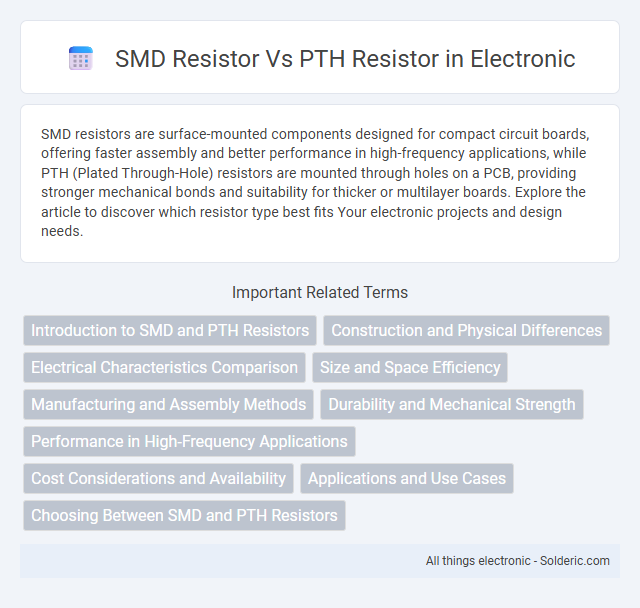SMD resistors are surface-mounted components designed for compact circuit boards, offering faster assembly and better performance in high-frequency applications, while PTH (Plated Through-Hole) resistors are mounted through holes on a PCB, providing stronger mechanical bonds and suitability for thicker or multilayer boards. Explore the article to discover which resistor type best fits Your electronic projects and design needs.
Comparison Table
| Feature | SMD Resistor | PTH Resistor |
|---|---|---|
| Mounting Type | Surface Mount Device (SMD) | Plated Through-Hole (PTH) |
| Size | Compact, small footprint | Larger, bulkier |
| Assembly Speed | Fast automated placement | Slower manual or wave soldering |
| Performance | Better high-frequency response | Less optimal for high-frequency circuits |
| Mechanical Strength | Lower, prone to damage under stress | Higher, robust for mechanical strain |
| Thermal Management | Limited heat dissipation | Better heat dissipation due to leads |
| Cost | Generally lower cost in mass production | Higher cost due to assembly process |
| Repair & Replacement | More difficult to replace manually | Easier to replace manually |
| Applications | Compact, high-density PCBs, modern electronics | Prototyping, through-hole boards, high-power circuits |
Introduction to SMD and PTH Resistors
SMD resistors, or Surface-Mount Devices, are compact components designed for automated placement on the surface of printed circuit boards (PCBs), offering high efficiency and space-saving benefits. PTH resistors, or Plated Through-Hole resistors, feature leads that pass through holes on the PCB for soldering, providing robust mechanical connections ideal for high-power applications. Your choice between SMD and PTH resistors depends on factors like board space, assembly process, and performance requirements.
Construction and Physical Differences
SMD resistors are surface-mounted components with a flat, rectangular shape made of a ceramic substrate coated with a resistive element, designed for automated placement on PCB surfaces. PTH resistors, or plated through-hole resistors, have axial leads and a cylindrical body, inserted into drilled holes on PCBs and soldered on the opposite side, providing strong mechanical stability. The compact, low-profile design of SMD resistors contrasts with the larger, leaded structure of PTH resistors, affecting assembly methods and space utilization on circuit boards.
Electrical Characteristics Comparison
SMD resistors exhibit lower parasitic inductance and capacitance compared to PTH resistors, resulting in superior high-frequency performance and reduced signal distortion. Their smaller size and surface mounting facilitate better thermal dissipation and consistent resistance values under varying temperatures. PTH resistors typically have higher power ratings but suffer from increased lead inductance, affecting their suitability in high-speed or high-frequency circuits.
Size and Space Efficiency
SMD resistors are significantly smaller than PTH resistors, often measuring just a few millimeters, making them ideal for compact circuit designs. Their low profile and surface-mount installation enable more efficient use of PCB space, allowing for higher component density. In contrast, PTH resistors require drilled holes, consuming more board area and limiting miniaturization in densely packed electronic assemblies.
Manufacturing and Assembly Methods
SMD resistors are manufactured using surface-mount technology (SMT), which places components directly onto the surface of printed circuit boards (PCBs) through automated pick-and-place machines, allowing for high-speed and precise assembly. PTH (plated through-hole) resistors require insertion into drilled holes on the PCB, followed by wave soldering or hand soldering, which is generally slower and less suited for automated mass production. The SMT process of SMD resistors supports miniaturization and higher component density, whereas PTH resistors typically offer stronger mechanical bonding but with reduced assembly efficiency.
Durability and Mechanical Strength
SMD resistors generally offer superior durability and mechanical strength compared to PTH resistors due to their smaller size and surface-mount design, which reduces stress from vibration and thermal expansion. PTH resistors, inserted through holes and soldered on both sides, provide strong physical anchoring but are more susceptible to damage from mechanical shock and board flexing. Choosing the right type depends on Your device's operational environment and the balance needed between mechanical resilience and assembly constraints.
Performance in High-Frequency Applications
SMD resistors exhibit superior performance in high-frequency applications due to their lower parasitic inductance and capacitance compared to PTH resistors, enabling better signal integrity and reduced noise. The minimized lead length and smaller size of SMD resistors facilitate faster response times and lower impedance at high frequencies. PTH resistors, with longer leads and higher parasitic elements, often introduce unwanted inductance and signal distortion, limiting their effectiveness in RF and microwave circuits.
Cost Considerations and Availability
SMD resistors generally offer lower cost and higher availability due to mass production and widespread use in modern electronics, making them ideal for high-volume manufacturing. PTH resistors tend to be more expensive and less available, mainly used in applications requiring mechanical strength or higher power ratings. Inventory for SMD resistors is typically more extensive, ensuring easier sourcing and faster lead times compared to PTH resistors.
Applications and Use Cases
SMD resistors are ideal for compact, high-density circuit boards used in smartphones, laptops, and wearable devices due to their small size and automated assembly compatibility. PTH resistors are preferred in power electronics, industrial equipment, and connectors requiring higher power dissipation and mechanical strength. SMD resistors excel in surface-mount technology for mass production, while PTH resistors are advantageous in prototyping and through-hole board designs demanding robust physical connections.
Choosing Between SMD and PTH Resistors
Choosing between SMD (Surface-Mount Device) and PTH (Plated Through-Hole) resistors depends on your circuit design requirements, assembly process, and space constraints. SMD resistors offer compact size, automated assembly compatibility, and better high-frequency performance, making them ideal for modern electronics with limited PCB space. Your decision should consider the mechanical strength needs and repairability, where PTH resistors provide robust mounting and easier manual soldering.
SMD resistor vs PTH resistor Infographic

 solderic.com
solderic.com